tire type DODGE CHALLENGER 2018 Vehicle Warranty
[x] Cancel search | Manufacturer: DODGE, Model Year: 2018, Model line: CHALLENGER, Model: DODGE CHALLENGER 2018Pages: 316, PDF Size: 3.15 MB
Page 293 of 316
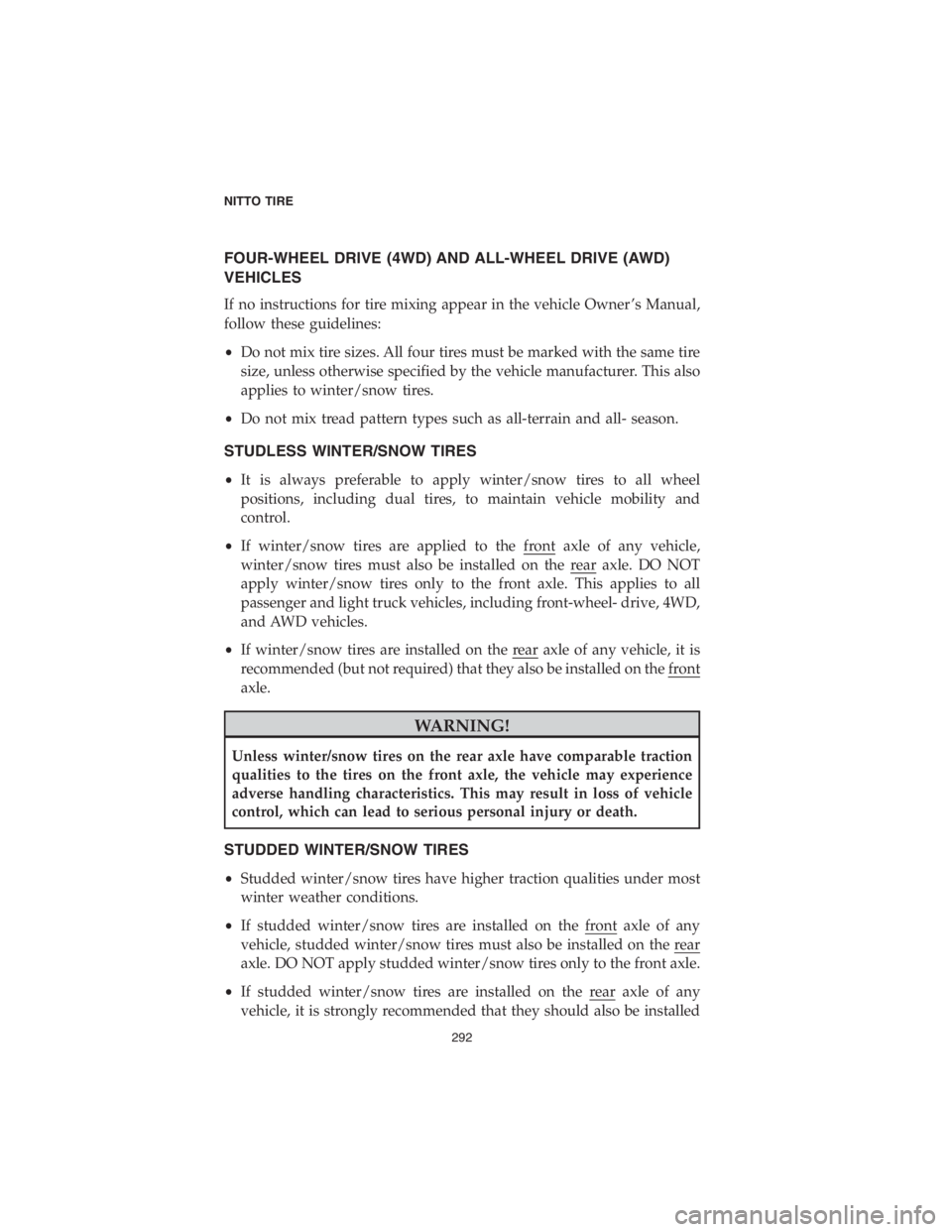
FOUR-WHEEL DRIVE (4WD) AND ALL-WHEEL DRIVE (AWD)
VEHICLES
If no instructions for tire mixing appear in the vehicle Owner ’s Manual,
follow these guidelines:
•Do not mix tire sizes. All four tires must be marked with the same tire
size, unless otherwise specified by the vehicle manufacturer. This also
applies to winter/snow tires.
•Do not mix tread pattern types such as all-terrain and all- season.
STUDLESS WINTER/SNOW TIRES
•It is always preferable to apply winter/snow tires to all wheel
positions, including dual tires, to maintain vehicle mobility and
control.
•If winter/snow tires are applied to the front axle of any vehicle,
winter/snow tires must also be installed on the rear axle. DO NOT
apply winter/snow tires only to the front axle. This applies to all
passenger and light truck vehicles, including front-wheel- drive, 4WD,
and AWD vehicles.
•If winter/snow tires are installed on the rear axle of any vehicle, it is
recommended (but not required) that they also be installed on the front
axle.
WARNING!
Unless winter/snow tires on the rear axle have comparable traction
qualities to the tires on the front axle, the vehicle may experience
adverse handling characteristics. This may result in loss of vehicle
control, which can lead to serious personal injury or death.
STUDDED WINTER/SNOW TIRES
•Studded winter/snow tires have higher traction qualities under most
winter weather conditions.
•If studded winter/snow tires are installed on the front axle of any
vehicle, studded winter/snow tires must also be installed on the rear
axle. DO NOT apply studded winter/snow tires only to the front axle.
•If studded winter/snow tires are installed on the rear axle of any
vehicle, it is strongly recommended that they should also be installed
NITTO TIRE
292
Page 299 of 316
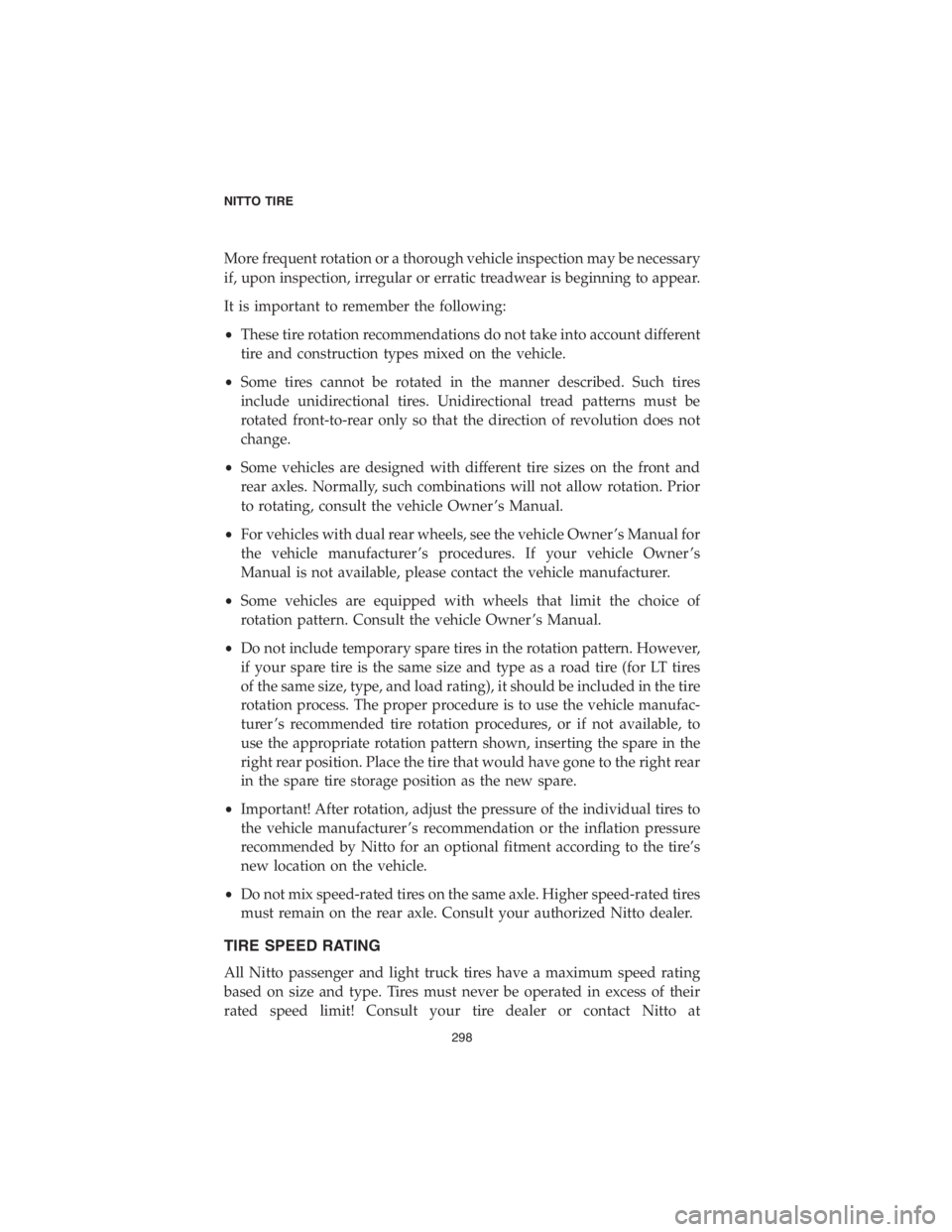
More frequent rotation or a thorough vehicle inspection may be necessary
if, upon inspection, irregular or erratic treadwear is beginning to appear.
It is important to remember the following:
•These tire rotation recommendations do not take into account different
tire and construction types mixed on the vehicle.
•Some tires cannot be rotated in the manner described. Such tires
include unidirectional tires. Unidirectional tread patterns must be
rotated front-to-rear only so that the direction of revolution does not
change.
•Some vehicles are designed with different tire sizes on the front and
rear axles. Normally, such combinations will not allow rotation. Prior
to rotating, consult the vehicle Owner ’s Manual.
•For vehicles with dual rear wheels, see the vehicle Owner ’s Manual for
the vehicle manufacturer ’s procedures. If your vehicle Owner ’s
Manual is not available, please contact the vehicle manufacturer.
•Some vehicles are equipped with wheels that limit the choice of
rotation pattern. Consult the vehicle Owner ’s Manual.
•Do not include temporary spare tires in the rotation pattern. However,
if your spare tire is the same size and type as a road tire (for LT tires
of the same size, type, and load rating), it should be included in the tire
rotation process. The proper procedure is to use the vehicle manufac-
turer ’s recommended tire rotation procedures, or if not available, to
use the appropriate rotation pattern shown, inserting the spare in the
right rear position. Place the tire that would have gone to the right rear
in the spare tire storage position as the new spare.
•Important! After rotation, adjust the pressure of the individual tires to
the vehicle manufacturer ’s recommendation or the inflation pressure
recommended by Nitto for an optional fitment according to the tire’s
new location on the vehicle.
•Do not mix speed-rated tires on the same axle. Higher speed-rated tires
must remain on the rear axle. Consult your authorized Nitto dealer.
TIRE SPEED RATING
All Nitto passenger and light truck tires have a maximum speed rating
based on size and type. Tires must never be operated in excess of their
rated speed limit! Consult your tire dealer or contact Nitto at
NITTO TIRE
298
Page 304 of 316
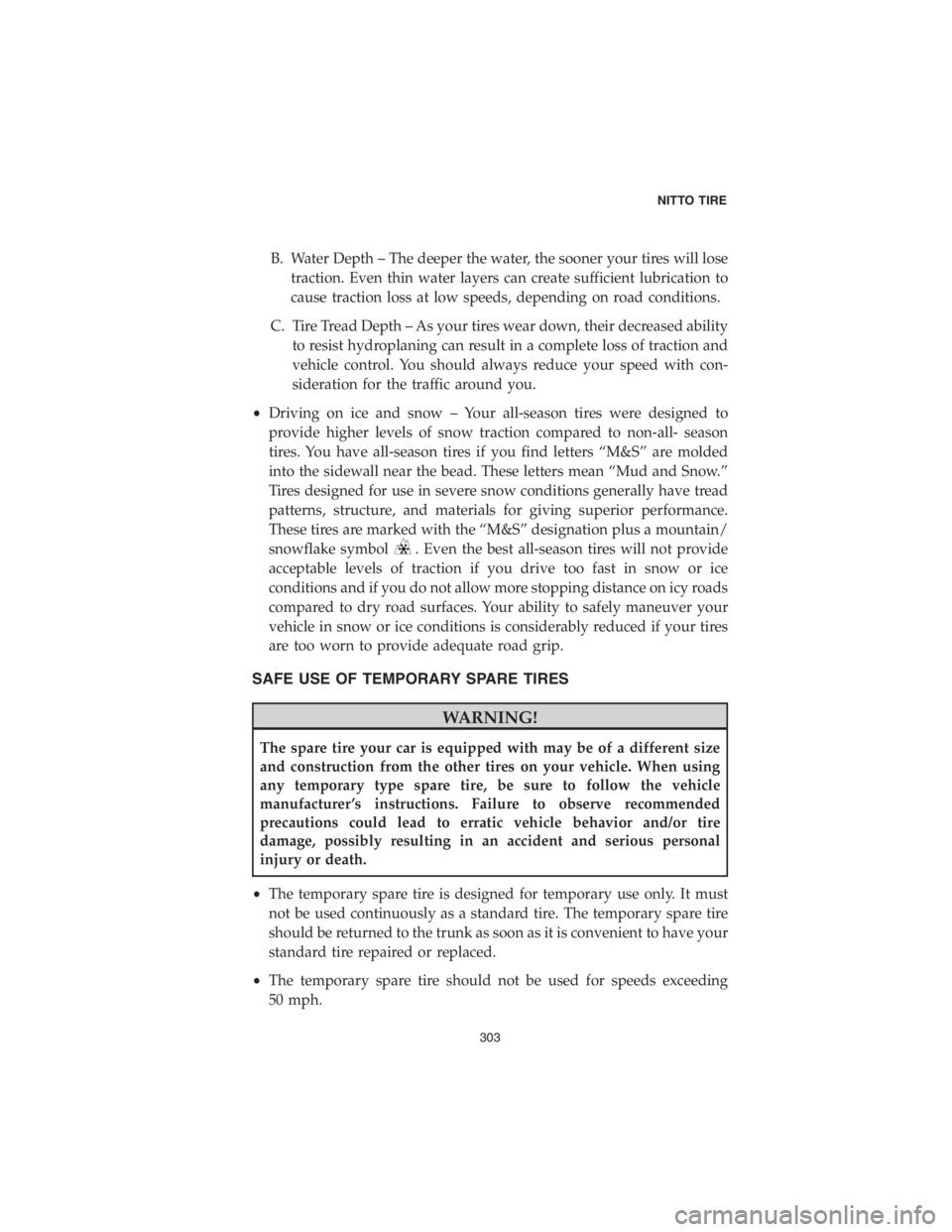
B. Water Depth – The deeper the water, the sooner your tires will lose
traction. Even thin water layers can create sufficient lubrication to
cause traction loss at low speeds, depending on road conditions.
C. Tire Tread Depth – As your tires wear down, their decreased ability
to resist hydroplaning can result in a complete loss of traction and
vehicle control. You should always reduce your speed with con-
sideration for the traffic around you.
•Driving on ice and snow – Your all-season tires were designed to
provide higher levels of snow traction compared to non-all- season
tires. You have all-season tires if you find letters “M&S” are molded
into the sidewall near the bead. These letters mean “Mud and Snow.”
Tires designed for use in severe snow conditions generally have tread
patterns, structure, and materials for giving superior performance.
These tires are marked with the “M&S” designation plus a mountain/
snowflake symbol
. Even the best all-season tires will not provide
acceptable levels of traction if you drive too fast in snow or ice
conditions and if you do not allow more stopping distance on icy roads
compared to dry road surfaces. Your ability to safely maneuver your
vehicle in snow or ice conditions is considerably reduced if your tires
are too worn to provide adequate road grip.
SAFE USE OF TEMPORARY SPARE TIRES
WARNING!
The spare tire your car is equipped with may be of a different size
and construction from the other tires on your vehicle. When using
any temporary type spare tire, be sure to follow the vehicle
manufacturer ’s instructions. Failure to observe recommended
precautions could lead to erratic vehicle behavior and/or tire
damage, possibly resulting in an accident and serious personal
injury or death.
•The temporary spare tire is designed for temporary use only. It must
not be used continuously as a standard tire. The temporary spare tire
should be returned to the trunk as soon as it is convenient to have your
standard tire repaired or replaced.
•The temporary spare tire should not be used for speeds exceeding
50 mph.
NITTO TIRE
303
Page 305 of 316
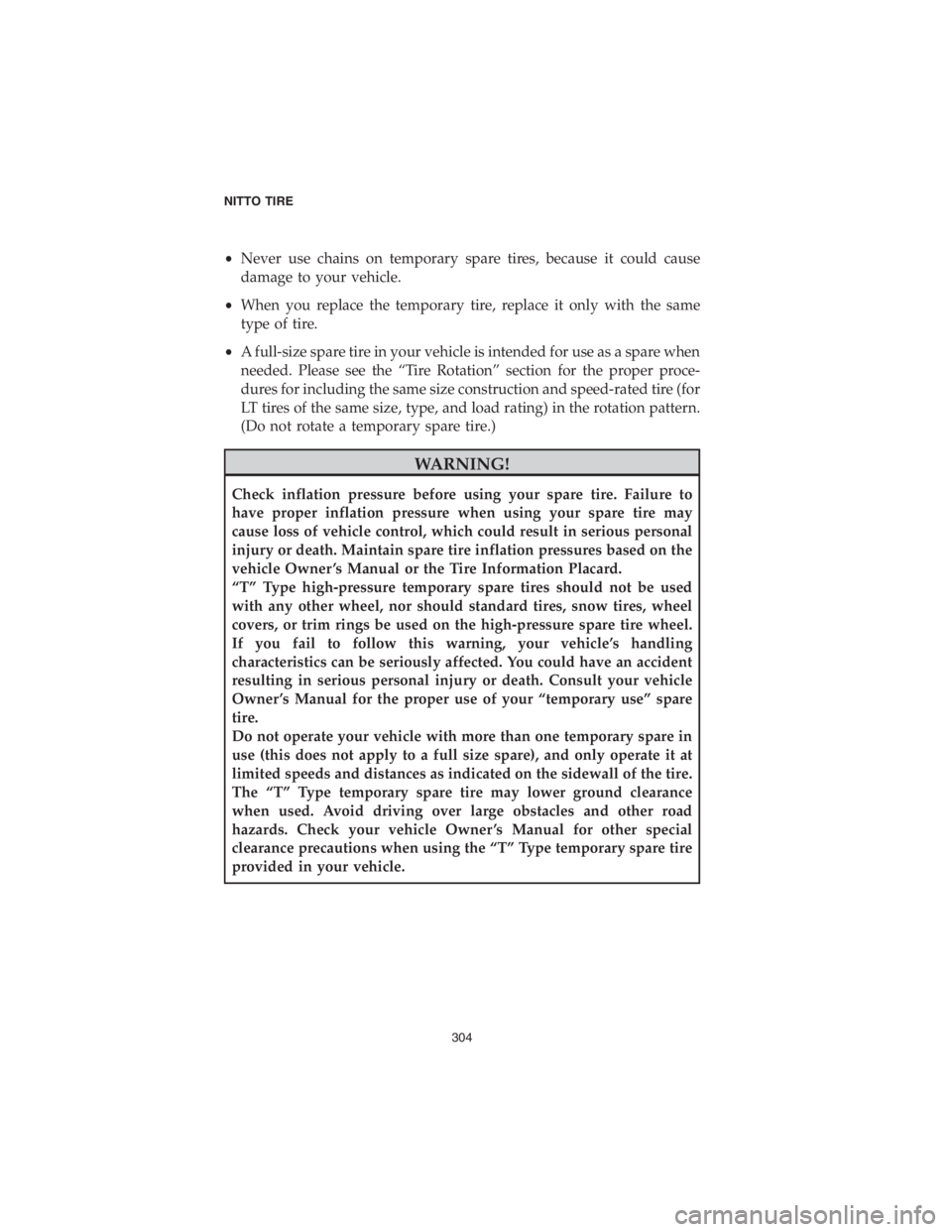
•Never use chains on temporary spare tires, because it could cause
damage to your vehicle.
•When you replace the temporary tire, replace it only with the same
type of tire.
•A full-size spare tire in your vehicle is intended for use as a spare when
needed. Please see the “Tire Rotation” section for the proper proce-
dures for including the same size construction and speed-rated tire (for
LT tires of the same size, type, and load rating) in the rotation pattern.
(Do not rotate a temporary spare tire.)
WARNING!
Check inflation pressure before using your spare tire. Failure to
have proper inflation pressure when using your spare tire may
cause loss of vehicle control, which could result in serious personal
injury or death. Maintain spare tire inflation pressures based on the
vehicle Owner ’s Manual or the Tire Information Placard.
“T” Type high-pressure temporary spare tires should not be used
with any other wheel, nor should standard tires, snow tires, wheel
covers, or trim rings be used on the high-pressure spare tire wheel.
If you fail to follow this warning, your vehicle’s handling
characteristics can be seriously affected. You could have an accident
resulting in serious personal injury or death. Consult your vehicle
Owner ’s Manual for the proper use of your “temporary use” spare
tire.
Do not operate your vehicle with more than one temporary spare in
use (this does not apply to a full size spare), and only operate it at
limited speeds and distances as indicated on the sidewall of the tire.
The “T” Type temporary spare tire may lower ground clearance
when used. Avoid driving over large obstacles and other road
hazards. Check your vehicle Owner ’s Manual for other special
clearance precautions when using the “T” Type temporary spare tire
provided in your vehicle.
NITTO TIRE
304
Page 309 of 316
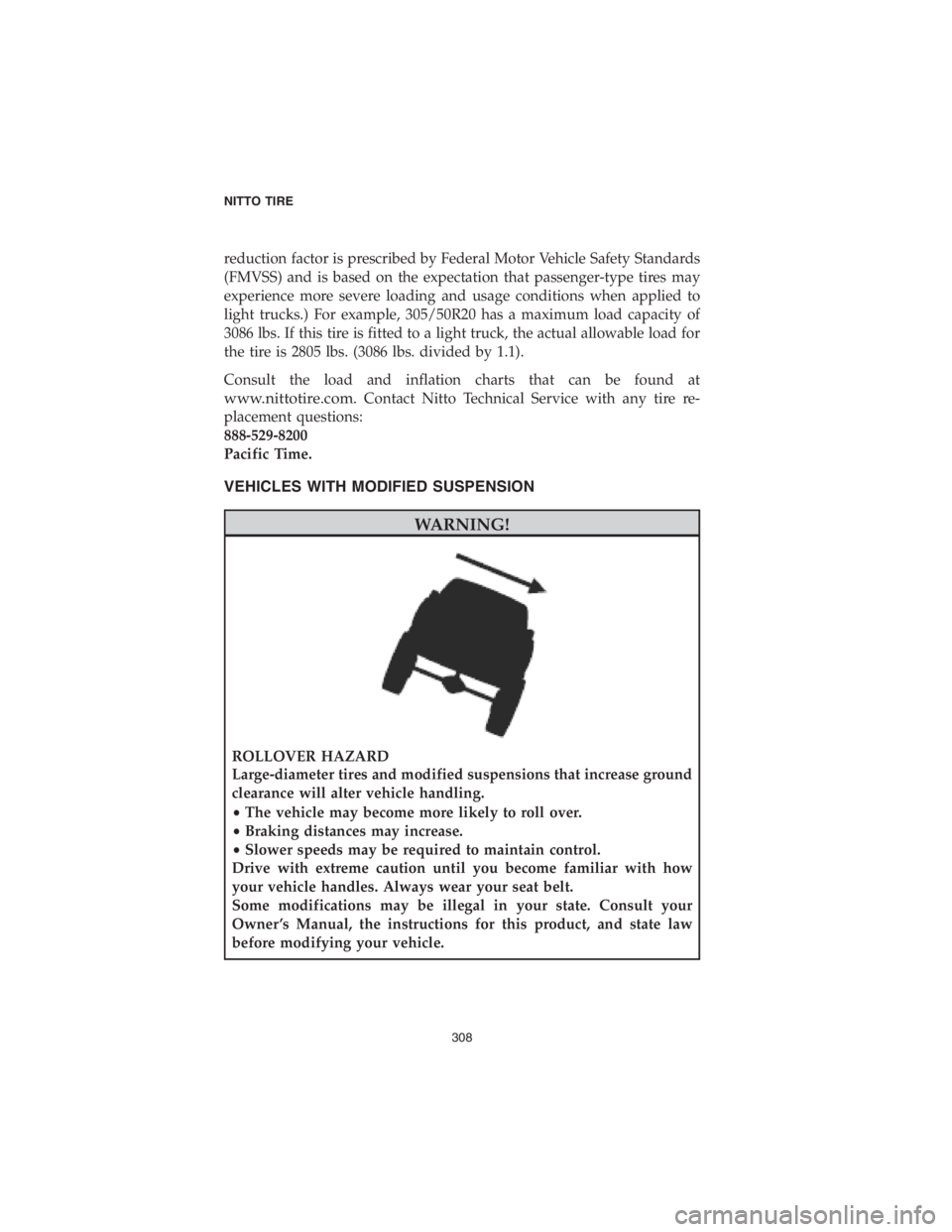
reduction factor is prescribed by Federal Motor Vehicle Safety Standards
(FMVSS) and is based on the expectation that passenger-type tires may
experience more severe loading and usage conditions when applied to
light trucks.) For example, 305/50R20 has a maximum load capacity of
3086 lbs. If this tire is fitted to a light truck, the actual allowable load for
the tire is 2805 lbs. (3086 lbs. divided by 1.1).
Consult the load and inflation charts that can be found at
www.nittotire.com. Contact Nitto Technical Service with any tire re-
placement questions:
888-529-8200
Pacific Time.
VEHICLES WITH MODIFIED SUSPENSION
WARNING!
ROLLOVER HAZARD
Large-diameter tires and modified suspensions that increase ground
clearance will alter vehicle handling.
•The vehicle may become more likely to roll over.
•Braking distances may increase.
•Slower speeds may be required to maintain control.
Drive with extreme caution until you become familiar with how
your vehicle handles. Always wear your seat belt.
Some modifications may be illegal in your state. Consult your
Owner ’s Manual, the instructions for this product, and state law
before modifying your vehicle.
NITTO TIRE
308
Page 310 of 316
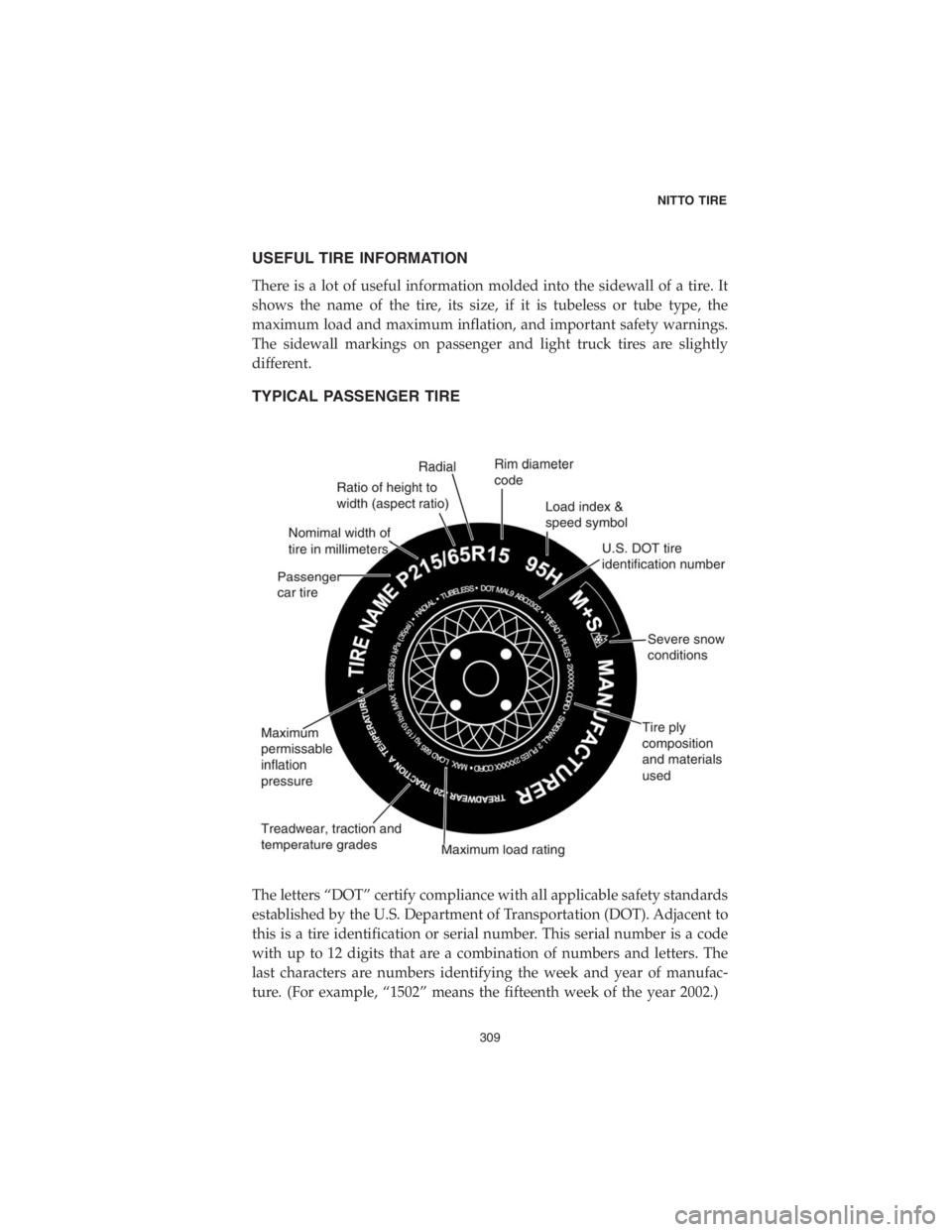
USEFUL TIRE INFORMATION
There is a lot of useful information molded into the sidewall of a tire. It
shows the name of the tire, its size, if it is tubeless or tube type, the
maximum load and maximum inflation, and important safety warnings.
The sidewall markings on passenger and light truck tires are slightly
different.
TYPICAL PASSENGER TIRE
The letters “DOT” certify compliance with all applicable safety standards
established by the U.S. Department of Transportation (DOT). Adjacent to
this is a tire identification or serial number. This serial number is a code
with up to 12 digits that are a combination of numbers and letters. The
last characters are numbers identifying the week and year of manufac-
ture. (For example, “1502” means the fifteenth week of the year 2002.)
NITTO TIRE
309
Page 311 of 316
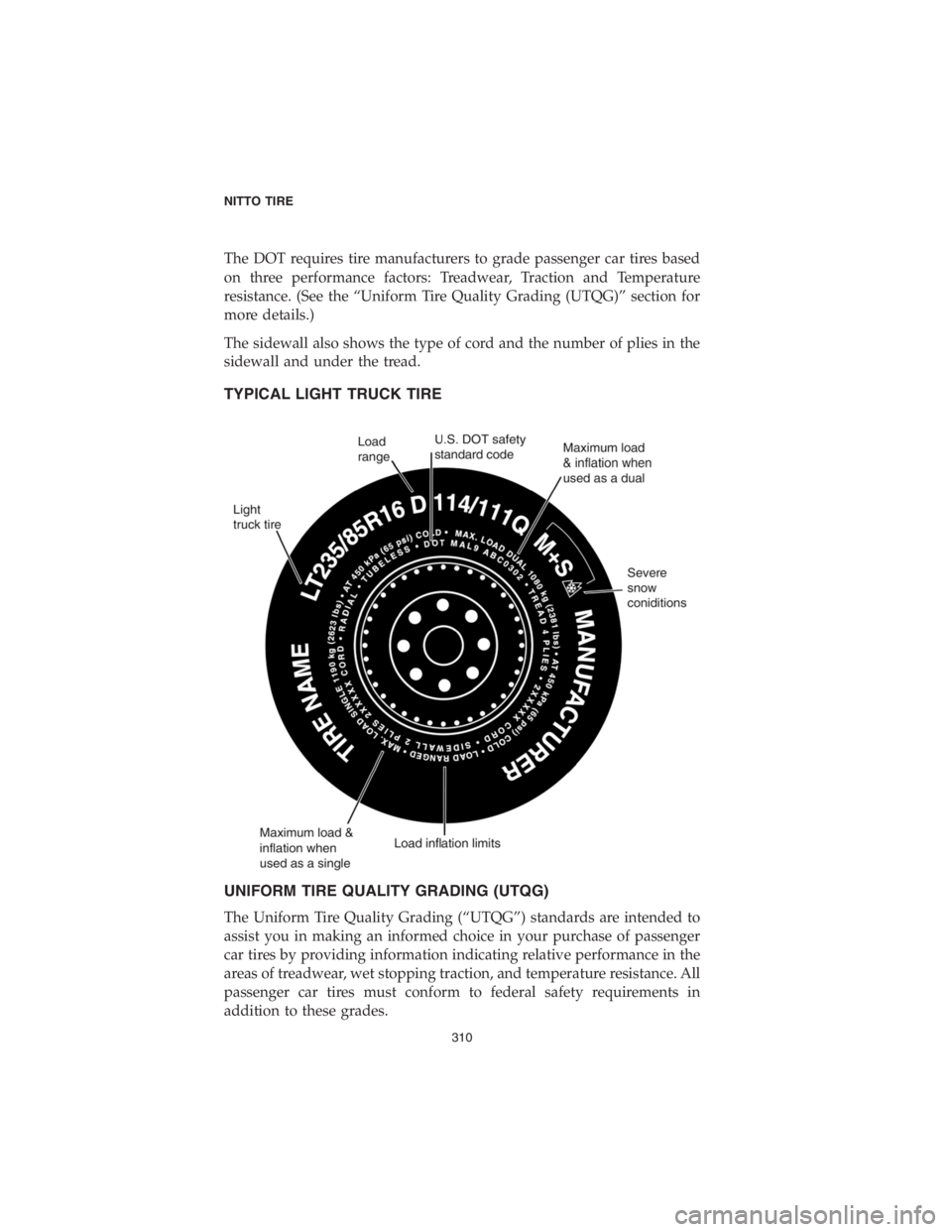
The DOT requires tire manufacturers to grade passenger car tires based
on three performance factors: Treadwear, Traction and Temperature
resistance. (See the “Uniform Tire Quality Grading (UTQG)” section for
more details.)
The sidewall also shows the type of cord and the number of plies in the
sidewall and under the tread.
TYPICAL LIGHT TRUCK TIRE
UNIFORM TIRE QUALITY GRADING (UTQG)
The Uniform Tire Quality Grading (“UTQG”) standards are intended to
assist you in making an informed choice in your purchase of passenger
car tires by providing information indicating relative performance in the
areas of treadwear, wet stopping traction, and temperature resistance. All
passenger car tires must conform to federal safety requirements in
addition to these grades.
NITTO TIRE
310